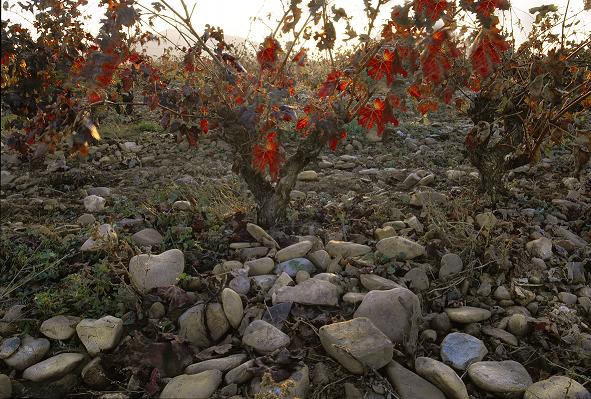We mentioned in the previous post that the leiv motiv of Familia Martínez Bujanda is the concept of the estate. What we usually define as ‘terroir‘, a concept adapted from French viticulture and sometimes translated in Spain as ‘terroir’, responds to several key factors that determine not only the quality but also the identity of a wine.
The ‘terroir’ is made up, first and foremost, of the soil in which the vineyard is grown. In the case of Finca Valpiedra, our soil is specific and different from the most common soils found in Rioja.
Valpiedra is a wonderful site of 80 hectares, associated with the Grandes Pagos de España and located on a meander of the Ebro, with clay soils and a mantle of boulders and limestone that are, precisely, the iconography of our wines.
The ridges, soils characteristic of some areas of the Rhône in France, for example, retain humidity and at the same time the sun’s heat, which continues to radiate for a few hours in the cold night, which usually helps us in the ripening of the grapes. In this sense, this singularity has been key in the last vintage, 2014, as it allowed us to harvest before the October rains, which were very harmful, in general, for the 2014 vintage in Rioja.
Our microclimate, the second component of terroir, is also unique. The Sierra de Cantabria, just on the other side of the Ebro, protects us from the cold and the Atlantic rains, although it practically pushes viticulture to the limit. At the other extreme (south) we have the Sierra de la Demanda, with a more continental Mediterranean climate (cold and dry), which means that, in certain vintages, our wines have a warmer profile (Mediterranean), with very high temperatures in summer, and others cooler and rainy (Atlantic).
The grape varieties is the third factor of ‘terroir’ and, in our case, we have opted for the autochthonous varieties, those that have been adapted for centuries in La Rioja Alta, such as tempranillowith small contributions from graciano and new plantations of maturana inkThis is a historic grape in the nearby region of Navarrete and, due to its structure and depth, we believe it will adapt very well to our terroir.
Finally, cultural practices are the fourth fundamental component of Finca Valpiedra’s terroir and, in this case, our technical team strives every day from pruning to harvest to contain yields and manage the vegetation in order to be able, weather permitting, to offer our customers the best possible wine each vintage.
At Finca Valpiedra we do not make the best wines in Rioja, but we do produce the best we know how to make in order to maximize the expression of our own terroir: wines with the personality and identity of our terroir.The consumer, each vintage, will be able to find the different nuances that nature offers us.




